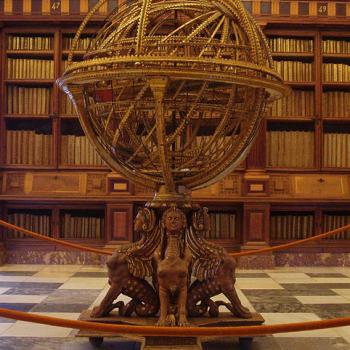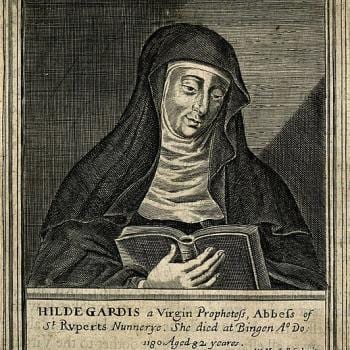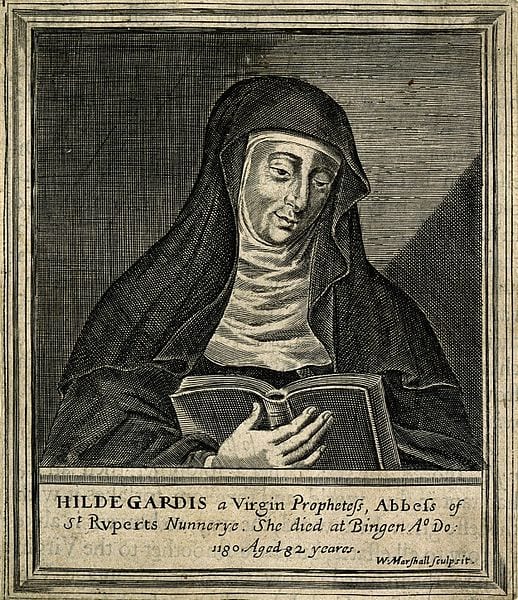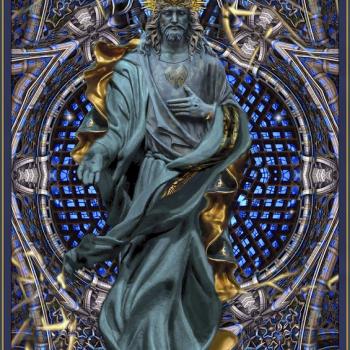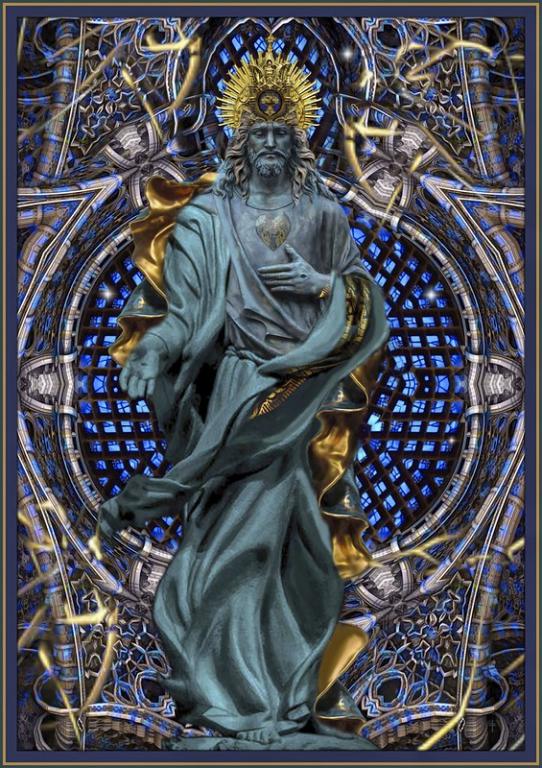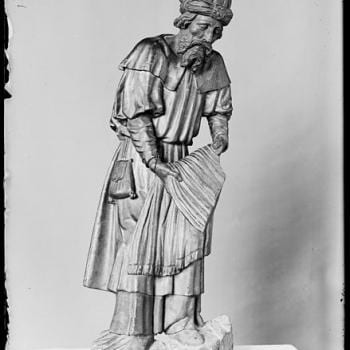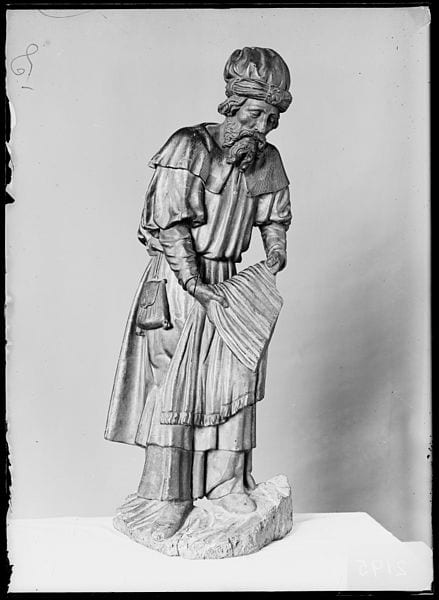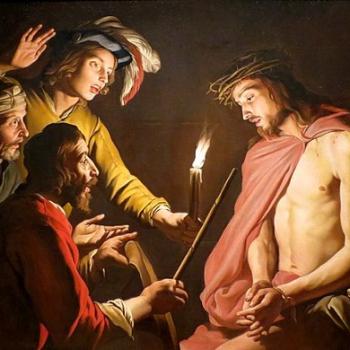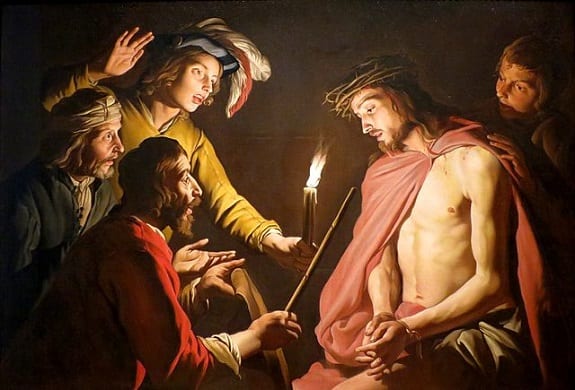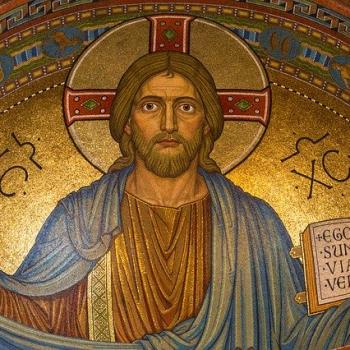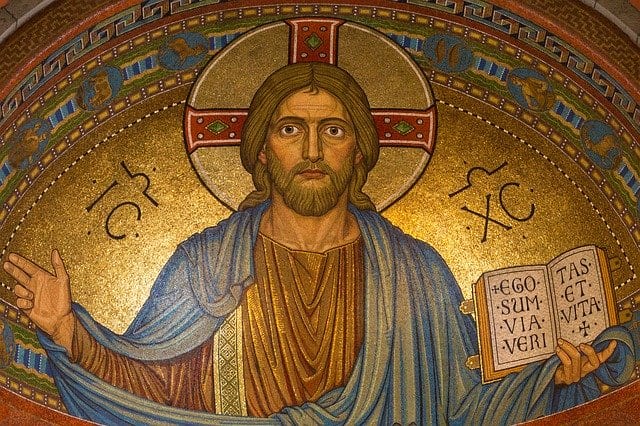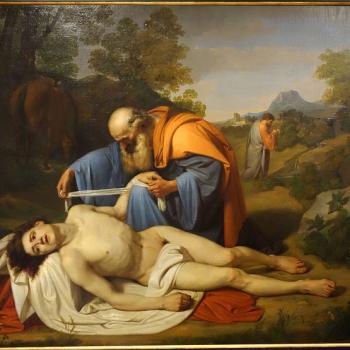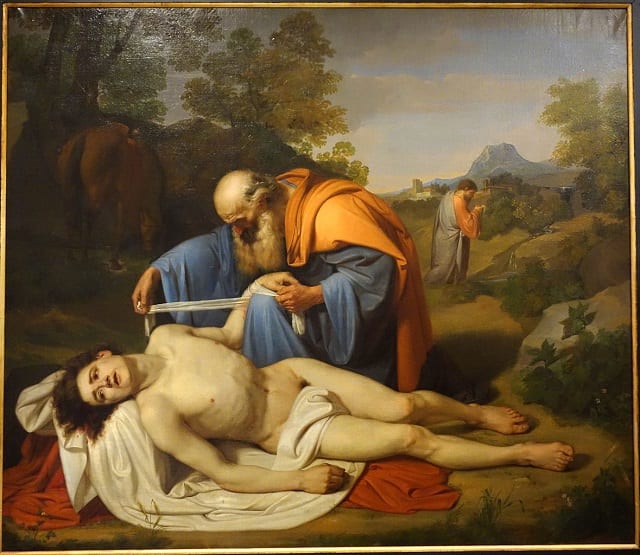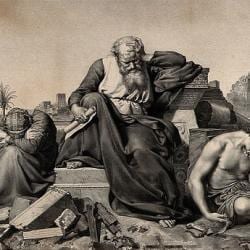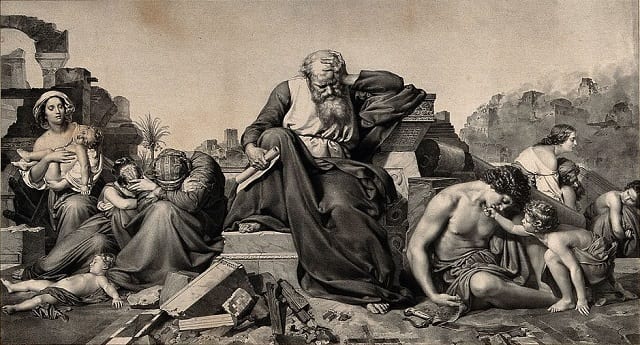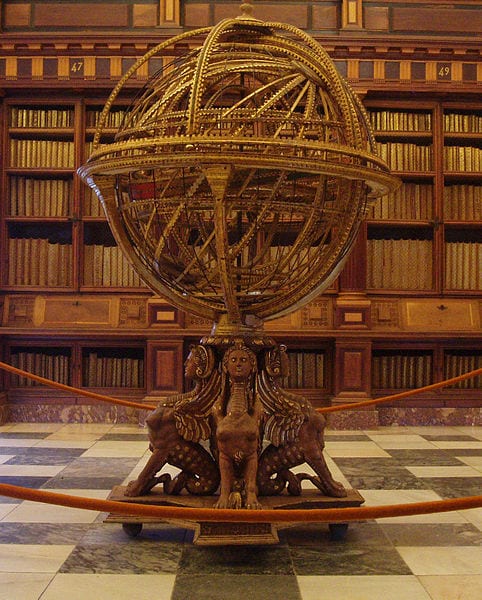
Atheist and anti-theist Bob Seidensticker, who was “raised Presbyterian”, runs the influential Cross Examined blog. He asked me there, on 8-11-18: “I’ve got 1000+ posts here attacking your worldview. You just going to let that stand? Or could you present a helpful new perspective that I’ve ignored on one or two of those posts?” He added in June 2017 in a combox: “If I’ve misunderstood the Christian position or Christian arguments, point that out. Show me where I’ve mischaracterized them.” Delighted to oblige his wishes . . .
Bob (for the record) virtually begged and pleaded with me to dialogue with him in May 2018, via email. But by 10-3-18, following massive, childish name-calling attacks against me, encouraged by Bob on his blog, he banned me from commenting there. I also banned him for violation of my rules for discussion, but (unlike him) provided detailed reasons for why it was justified.
Bob’s cowardly hypocrisy knows no bounds. On 6-30-19, he was chiding someone for something very much like his own behavior: “Spoken like a true weasel trying to run away from a previous argument. You know, you could just say, ‘Let me retract my previous statement of X’ or something like that.” Yeah, Bob could! He still hasn’t yet uttered one peep in reply to — now — 59 of my critiques of his atrocious reasoning.
Bible-Basher Bob reiterated and rationalized his intellectual cowardice yet again on 10-17-20: “Every engagement with him [yours truly] devolves into pointlessness. I don’t believe I’ve ever learned anything from him. But if you find a compelling argument of his, summarize it for us.” And again the next day: “He has certainly not earned a spot in my heart, so I will pass on funding his evidence-free project. Like you, I also find that he’s frustrating to talk with. Again, I evaluate such conversations as useful if I can learn something–find a mistake in my argument, uncover an error I made in Christians’ worldview, and so on. Dave is good at bluster, and that’s about it.”
Bible-Basher Bob’s words will be in blue. To find these posts, follow this link: “Seidensticker Folly #” or see all of them linked under his own section on my Atheism page.
*****
The following is a critique of a portion of Bob’s article, “Yeah, but Christianity Built Hospitals!” (4-22-20; update of 2-6-16).
Christianity’s poor attitude toward learning
Christianity had an uneasy relationship with any ideas that didn’t directly support the Church. The 1559 Index Librorum Prohibitorum listed books by 550 authors that were prohibited by the Roman Catholic Church, though prior lists had prohibited books almost since the beginning of Christianity. The list is a Who’s Who of Western thought and included works by Sartre, Voltaire, Hugo, Copernicus, Kepler, Galileo, Hobbes, Spinoza, Kant, Hume, Descartes, Bacon, Milton, Locke, and Pascal. The List was abolished only in 1966.
Dr. Peter Harrison said, “From the patristic period to the beginning of the seventeen [sic] century curiosity was regarded as an intellectual vice.” . . .
This aversion to knowledge is ironic because when the Church was motivated, it could accomplish great things. My favorite example is the thirteenth-century explosion of innovative cathedrals that still stand today.
It’s the same old tired saw of “Christianity [especially when it was the dominant cultural force] was [is?] anti-science, anti-intellectual, and opposed to the impulse and ‘curiosity’ of investigative science or any other sort of learning.” In addition to being a slander of historic Christianity (Catholicism and Orthodoxy), this is also an indefensible and reprehensible slander of the entire period of the Middle Ages (generally considered to be the age from about 400 to 1400 or 1500).
I don’t really need to do fresh research to rebut this groundless claim because I have already done so: in my book, Science and Christianity: Close Partners or Mortal Enemies? (2010). I shall simply cite mountains of evidence of eminent Christians and Churchmen and Churchwomen who exhibited quite a bit of “curiosity”: directly and manifestly contrary to Bob’s idiotic and prejudicial sweeping claim.
As for the oft-cited Index Librorum Prohibitorum I shall make two observations (as one who is a big proponent of free inquiry and open discussion amongst all parties of differing worldviews: as is well-evidenced on my blog, with its 1000 or so dialogues). The first is that all schools of thought have tended to censor opposing beliefs, on the grounds that they were subversive or dangerous. Catholics are by no means at all unique in this respect.
Christians of all stripes have done it, and atheists, secularists, and those non-Christian religions have as well. Catholicism itself was illegal (often under the pain of death) for almost 300 years in England. The first thing the Nazis did was burn Christian books and indeed books of any opposing views at all. Communists did likewise. So did the anti-Catholics and anti-traditionalists of the French Revolution. They knew full well who their opponents were.
Secondly, this tendency today is far more in evidence amongst secularists than among Christians. It’s big tech outfits like Facebook and Google and Twitter who are famously, notoriously, and rather openly, censoring or outright banning any views to the right of their own far left ones. This isn’t even arguable. The evidence is overwhelming. It’s largely the same with the liberal-dominated mass media. They won’t even run at all, stories of Democrat corruption and abuses of power that make the Watergate scandal look like a kid stealing a cookie. Watergate was front page news for at least three years (much like the farcical Mueller Investigation was). I know; I lived through it.
This being the case, it’s equal parts ironic and ridiculous for an atheist like Bob to come around and start blasting the Catholic Church for past policies of censorship (most prominent instances of of them being from the remote and distant past). People in glass houses . . .
Now onto the actual historical evidence of medieval Christian “curiosity” and the inquiring, investigative, proto-scientific spirit that Bob rarely wants to examine in any depth or seriousness. He’d rather caricature and broad-brush from a distance, and create non-historical myths, fiction, and fantasies. I shall draw first from my paper, “33 Empiricist Christian Thinkers Before 1000 A. D.”: extracted from my book. Further bibliographical information can be found there.
St. Clement of Rome (d. c. 101; pope) He accepted a good deal of Greek mathematics and astronomy, including belief that the earth was spherical. Unlike Aristotle, however, for him the earth was not eternal and it was sharply distinguished from the divine.
St. Gregory Nazianzus (329-389; bishop and Doctor of the Church) wrote: “as we have compounded healthful drugs from certain of the reptiles; so from secular literature we have received principles of enquiry and speculation . . .”
St. Basil the Great (c. 330-379; bishop and Doctor of the Church) In contrast to Aristotle, he believed the heavens and the earth were made up of the same materials: earth, air, fire and water, and also questioned the Aristotelian view that divine spirits in the heavenly bodies must continue imparting motion directly to everything that moves. By analogy with a child’s top, he spoke of the heavenly bodies, “which after the first impulse, continue their revolutions, turning upon themselves when once fixed in their centre; thus nature, receiving the impulse of this first command, follows without interruption the course of the ages”. Basil’s spinning top provides an early formulation of the idea of impetus. His views on creation allow for the principle of the conservation of momentum, or of inertia.
St. Gregory of Nyssa (c. 335-c. 394; bishop) wrote about the spherical earth:
As, when the sun shines above the earth, the shadow is spread over its lower part, because its spherical shape makes it impossible for it to be clasped all round at one and the same time by the rays, and necessarily, on whatever side the sun’s rays may fall on some particular point of the globe, if we follow a straight diameter, we shall find shadow upon the opposite point, and so, continuously, at the opposite end of the direct line of the rays shadow moves round that globe, keeping pace with the sun, so that equally in their turn both the upper half and the under half of the earth are in light and darkness.
St. Ambrose (c. 336-397; bishop and Doctor of the Church) believed in a spherical earth.
[H]is work is full of observation of the facts of the natural world. He has minute descriptions of quails and storks and swallows, of bees and crickets, of trees and their modes of reproduction, of evaporation and the action of rain, of human anatomy and physiology.
St. Augustine (354-430; bishop and Doctor of the Church) was the dominant thinker of the first thousand years of Christian history. For him, the universe, being the creation of God, was not eternal but finite in space and time. Time itself had its created beginning. . . . The Greek notion of cyclic returns was ridiculous, and eliminated the possibility of happiness. He wrote, about science and Scripture:
Usually, even a non-Christian knows something about the earth, the heavens, and the other elements of this world, about the motion and orbit of the stars and even their size and relative positions, about the predictable eclipses of the sun and moon, the cycles of the years and the seasons, about the kinds of animals, shrubs, stones, and so forth, and this knowledge he hold to as being certain from reason and experience. Now, it is a disgraceful and dangerous thing for an infidel to hear a Christian, presumably giving the meaning of Holy Scripture, talking nonsense on these topics; and we should take all means to prevent such an embarrassing situation, in which people show up vast ignorance in a Christian and laugh it to scorn. The shame is not so much that an ignorant individual is derided, but that people outside the household of faith think our sacred writers held such opinions, and, to the great loss of those for whose salvation we toil, the writers of our Scripture are criticized and rejected as unlearned men. If they find a Christian mistaken in a field which they themselves know well and hear him maintaining his foolish opinions about our books, how are they going to believe those books in matters concerning the resurrection of the dead, the hope of eternal life, and the kingdom of heaven, when they think their pages are full of falsehoods and on facts which they themselves have learnt from experience and the light of reason? Reckless and incompetent expounders of Holy Scripture bring untold trouble and sorrow on their wiser brethren when they are caught in one of their mischievous false opinions and are taken to task by those who are not bound by the authority of our sacred books. For then, to defend their utterly foolish and obviously untrue statements, they will try to call upon Holy Scripture for proof and even recite from memory many passages which they think support their position, although they understand neither what they say nor the things about which they make assertion.
In the same work (The Literal Meaning of Genesis), Augustine refers to the spherical earth:
[T]here was nothing to prevent the massive watery sphere from having day on one side by the presence of light, and on the other side, night by the absence of light. Thus, in the evening, darkness would pass to that side from which light would be turning to the other. (Bk. I, ch. 12, 25)
And he wrote about the moon being illuminated by the sun:
[I]t is not the heavenly body itself that changes but the illumined surface of it. . . . it is always full, though it does not always appear so to the inhabitants of earth. The same explanation holds even if it is illumined by the rays of the sun. . . . It is only when it is opposite the sun that the whole of its illuminated surface is visible to us. (Bk. II, ch. 11, 31, pp. 68-69)
He rejected astrology (something that Galileo and Kepler still had not done 1200 years later), partially on the basis of observation of twins:
[L]et us . . . wholeheartedly reject all subtleties of astrologers and their so-called scientific observations . . . which they fancy established by their theories. . . . with headstrong impiety they treat evil-doing that is justly reprehensible as if God were to blame as the maker of the stars, and not man as the author of his own sins. . . .
What is more absurd and stupid than, after assenting to the foregoing argument, to say that the influence and power of stars is only over the lives of men? Such a theory is refuted by the case of those twins that spend their lives in different circumstances, one prosperous and the other wretched . . . (Bk. II, ch. 17, 35-36, p. 71)
John F. McCarthy elaborates on St. Augustine’s positing of something not unlike theistic evolution:
This theory of primordial packages of forms later to emerge (often referred to by commentators as “seminal reasons”) is certainly developmental, but does not correspond with Darwinian evolution. Essential to Augustine’s theory is the idea that the order later to emerge was instilled by God in the beginning. Augustine also requires subsequent interventions by God to “plant” the forms whose “numbers” had already been instilled. Thus, as St. Thomas [Aquinas] points out, the ability of the earth to produce living forms was visualized by Augustine as a passive potency which disposed the matter to receive the forms but did not create the forms themselves. Augustine’s theory of primordial packages deserves more ample meditation and analysis in another place, especially with reference to theories of the development of living things, . . . Genesis 1:6-8 witnesses in several ways to the creative action of God. As the divine Fashioner of the universe, God guided the energies that He had invested in the primal matter by his creative intervention on the first day to bring the cosmos to its structured state. This is the unfolding of the active potency contained in St. Augustine’s “primordial packages.” But there is also implied in these verses an upward progress in the order of inorganic being which seems to have required additional creative divine interventions.
Anthemius of Tralles (c. 474-before 558) He collaborated with Isidore of Miletus to build the church of Hagia Sophia in Constantinople (what is today Istanbul in Turkey): the largest cathedral in the world for nearly a thousand years. He was also a capable mathematician. He described the string construction of the ellipse and he wrote a book on conic sections. Anthemius assumes a property of an ellipse not found in Apollonius work, that the equality of the angles subtended at a focus by two tangents drawn from a point, and having given the focus and a double ordinate he goes on to use the focus and directrix to obtain any number of points on a parabola—the first instance on record of the practical use of the directrix.
Boethius (c. 480-524) He documented several ideas relating science to music, including suggestions of sound waves (comparing sound to the waves made by throwing a stone into the water) and the notion that pitch is related to the physical property of frequency:
[W]hen air is struck and produces a sound, it impels other air next to it and in a certain way sets a rounded wave of air in motion, and is thus dispersed and strikes simultaneously the hearing of all who are standing around.
[T]he same string, if it is tightened further, givers a higher pitched sound; if it is loosened, a sound of lower pitch. For when it is tighter it renders a swifter impulse and returns more quickly, striking the air more frequently and more densely.
John Philoponus (c. 490-c. 570; aka John of Alexandria) [Monophysite, which is a difference in Christology] He was a professor in the school of philosophy in Alexandria, and the first to mount a devastating critique of the deductive method and much of the content of Aristotle’s physics and cosmology. There was no rival to its thoroughness until Galileo. For him, heavenly bodies were not animated beings, but were made of the same stuff as this world. The light from the stars was the same as that of glow-worms and luminescent fish. Astrology was rejected as pagan. Similarly, the heavenly bodies were not perfect. They did not move with regularity in the perfect shape of the circle – a simple matter of observation. The apparent changelessness of the universe did not mean that it is eternal. It had a beginning and will have an end. He rejected Aristotle’s view that heavier bodies fall faster than lighter ones (a thousand years before Galileo!).
He declared, “Our view may be corroborated by actual observation more effectively than by any sort of verbal argument.” His theories on motion were the forerunner of the later theories of inertia and momentum that are embedded in Newton’s first law of motion. As regards nature, he stated that God, having finished the creation of the universe, “hands over to nature the generation of the elements one out of another, and the generation of the rest out of the elements.” That sounds like a summary of the evolution of the universe from basic materials that modern science would identify with. The relative autonomy of nature, with its own order and laws, is basic to science, and these early Christian thinkers were laying the foundations. . . . Galileo knew the key work of Philoponus, from a thousand years earlier.
He accepted the sphericity of the earth. He understood light as something dynamical and that light and heat may best be explained as consequences of the nature of the sun, which is fire (In Meteor. 49). Heat is generated when the rays emanating from the sun are refracted and warm the air through friction. He concluded, against Aristotle, that there is in fact nothing to prevent one from imagining motion taking place through a void. As regards the natural motion of bodies falling through a medium, Aristotle’s verdict that the speed is proportional to the weight of the moving bodies and indirectly proportional to the density of the medium is disproved by Philoponus through appeal to the same kind of experiment that Galileo was to carry out centuries later (In Phys. 682-84). Philoponus insisted that a clear conception of the void is not only coherent but also necessary if one wants to explain movement in a plenum.
When bodies move and in consequence exchange places, this presupposes that somehow there is empty space available to be filled by them (In Phys. 693f.). Again, there are certain phenomena which clearly exhibit the force of the vacuum, for example handling a pipette (clepsudra), which allows one to raise small quantities of fluids, or the fact that one can suck up water through a pipe (In Phys. 571f). Philoponus’ elaborate defense of the void (In Phys. 675-94) is closely related to his conceptions of place and space (In Phys. 557-85). The De opificio mundi has received some attention from historians of science, because Philoponus suggests at one point (I 12) that the movement of the heavens could be explained by a ‘motive force’ impressed on the celestial bodies by God at the time of creation.
Philoponus compares the rotation implanted in the celestial bodies to the rectilinear movements of the elements as well as to the movements of animals: curiously, these are all understood as natural motions that are due to the creator’s divine impetus. In virtue of this bold suggestion Philoponus is often credited with having envisaged, for the first time, a unified theory of dynamics, since he strove to give the same kind of explanation for phenomena which Aristotle had to explain by different principles, depending upon their different cosmological contexts.
Paul of Aegina (c. 625-c. 690) He is considered by some to be the greatest Byzantine surgeon, developed many novel surgical techniques and authored the medical encyclopedia Medical Compendium in Seven Books. The book on surgery in particular was the definitive treatise in Europe and the Islamic world for hundreds of years, contained the sum of all Western medical knowledge and was unrivaled in its accuracy and completeness. The sixth book on surgery in particular was referenced in Europe and the Arab world throughout the Middle Ages and is of special interest for surgical history. The whole work in the original Greek was published in Venice in 1528, and another edition appeared in Basel in 1538.
Venerable Bede (c. 672-735; monk and Doctor of the Church) He understood that the moon affects tides, and that high water was not simultaneous on all the coasts of Britain (recognition of the progressive wave-like character of tides). On the Reckoning of Time (De temporum ratione) included an introduction to the traditional ancient and medieval view of the cosmos, including an explanation of how the spherical earth influenced the changing length of daylight (“the roundness of the Earth, for not without reason is it called ‘the orb of the world’ on the pages of Holy Scripture and of ordinary literature.” — section 32), of how the seasonal motion of the Sun and Moon influenced the changing appearance of the New Moon at evening twilight, and a quantitative relation between the changes of the Tides at a given place and the daily motion of the moon. Bede was lucid about earth’s sphericity, writing “We call the earth a globe, not as if the shape of a sphere were expressed in the diversity of plains and mountains, but because, if all things are included in the outline, the earth’s circumference will represent the figure of a perfect globe… For truly it is an orb placed in the center of the universe; in its width it is like a circle, and not circular like a shield but rather like a ball, and it extends from its center with perfect roundness on all sides.”
Charlemagne (c. 742-814; Roman emperor)
Charlemagne . . . and his great minister, Alcuin[c. 740-804], not only promoted medical studies n the schools they founded, but also made provision for the establishment of botanic gardens in which those herbs were especially cultivated which were supposed to have healing virtues.
Hunayn ibn Ishaq (also Hunain or Hunein; 809-873) [Nestorian] His monumental developments on the eye can be traced back to his innovative book, Ten Treatises on Ophthalmology: the first systematic book in this field. He explained in minute details about the eye, its diseases and their symptoms and treatments, and its anatomy – all possible by his extensive research and observations. For example, ibn Ishaq taught what cysts and tumors are and the swelling they cause, how to treat various corneal ulcers through surgery, and the therapy involved in repairing cataracts.
Pope Sylvester II (born Gerbert d’Aurillac) (c. 940-1003) As a scientist, was said to be far ahead of his time. Gerbert wrote a series of works dealing with matters of the quadrivium (arithmetic, geometry, astronomy, music), which he taught using the basis of the trivium (grammar, logic, and rhetoric). He is said to have introduced the use of Arabic figures into Western Europe, and to have invented the pendulum clock. In Rheims, he constructed a hydraulic-powered organ with brass pipes that excelled all previously known instruments, where the air had to be pumped manually. Gerbert reintroduced the astronomical armillary sphere to Latin Europe via Al-Andalus in the late 10th century as a visual aid for teaching mathematics and astronomy in the classroom; also the abacus. The polar circle on Gerbert’s sphere was located at 26 degrees, just several degrees off from the actual 23° 28′. His positioning of the Tropic of Cancer was nearly exact, while his positioning of the equator was exactly correct.
This is just up to 1000 AD. The Middle Ages continues on for another 400-500 years, with continuing expansion of scientific, mathematical, and philosophical knowledge. And so here are more very “curious” Christian thinkers who somehow managed to think despite the “oppressive” Church (so Bob would have us believe). The following is from my book about science: where the fuller bibliographical sources are located:
Blessed Hermann of Reichenau (1013–1054) He wrote several works on geometry and arithmetics and astronomical treatises (including instructions for the construction of an astrolabe, at the time a very novel device in Western Europe). He was disabled, having only limited movement and limited ability to speak. Despite these disabilities he was a key figure in the transmission of Arabic mathematics, astronomy and scientific instruments from Arabic sources into central Europe. He was among the earliest Christian scholars to estimate the circumference of Earth with Eratosthenes’ method. He believed in a spherical earth.
Adelard of Bath (c. 1080-c. 1152) He was one of the first to introduce the Indian number system to Europe. Adelard also displays original thought of a scientific bent, raising the question of the shape of the Earth (he believed it to be round) and the question of how it remains stationary in space, and also the interesting question of how far a rock would fall if a hole were drilled through the earth and a rock dropped in it, see center of gravity. He theorized that matter could not be destroyed (see Law of conservation of matter) and was also interested in the question of why water experiences difficulty flowing out of a container that has been turned upside down, see atmospheric pressure and vacuum. He contributed the first full Latin translation of Euclid’s Elements and introduced trigonometry to Europe as transmitted through Arabic astronomical tables. The Questions Naturales covers subjects such as plants and animals, the four elements, the hydrological cycle, weather, and astronomy.
Gerard of Cremona (1114-1187) He translated about 75 books from Arabic into Latin, including works on dialectic, geometry, philosophy, physics, and several other sciences. His activity as a translator helped bring the world of Arabian learning within the reach of the scholars of Latin Christendom and prepared the way for the Scholasticism of the thirteenth century. In this work Gerard was a pioneer.
Marius (fl. 1160) He composed On the Elements:
It is a most remarkable work, employing experiments in a sophisticated if not quite rigorous way, marking a significant advance in the theory of matter, studying with great subtlety the nature of a compound, utilizing a quantitative table to explain how the great variety of the world could arise from just four elements, eschewing magic, and exhibiting a thoroughgoing naturalism in its attitude towards the physical world. This treatise throws much new light on the nature and quality of twelfth-century science and forces a rethinking of the standard accounts of the history of chemistry in the Middle Ages. . . .
Marius explains the formation of stones and metals. Noting that a goldsmith’s pot becomes transparent and is changed to glass when subjected to great heat, he concludes that all stones are formed this way in nature by heat enclosed in the interior of the earth. . . .
De Elementis . . . is completely naturalistic and materialistic and free of any magical or animistic notions. It therefore represents a kind of early Latin chemistry whose existence has not previously been taken into account in histories of chemistry. . . .
The world of nature obeyed laws, and these laws were accessible to human reason. His presentation of this world does not consist of a string of ad hoc explanations, but rather of a carefully worked out, internally consistent, naturalistic scheme, based on a careful and accurate observation of nature and handled with considerable dialectical skill.
We conclude then that at least a part of twelfth-century science was . . . much more than a revival of Antiquity, important though this was. It was bold, original, imaginative and daring. At its best it was rigorous in its arguments and precise in its observations. (On the Elements [Marius], translation and introduction by Richard C. Dales, Univ. of California Press, 1977,pp. 1, 14, 35-36)
William of Conches (c. 1090-after 1154) His discussion of meteorology includes a description of air becoming less dense and colder as the altitude increases, and he attempts to explain the circulation of the air in connection with the circulation of the oceans.
St. Hildegard von Bingen (1098-1179; Benedictine abbess; Doctor of the Church) She believed in a spherical earth and depicted it several times in her work Liber Divinorum Operum. She wrote botanical and medicinal texts: Physica, on the natural sciences, and Causae et Curae. In both texts Hildegard describes the natural world around her, including the cosmos, animals, plants, stones, and minerals.
Rogerius (c. 1140-c. 1195) He wrote a work on medicine entitled Practica Chirurgiae (“The Practice of Surgery”): the first medieval text on surgery to dominate its field in Europe. It laid the foundation for the species of the occidental surgical manuals, influencing them up to modern times. The work, arranged anatomically and presented according to a pathologic–traumatological systematization, includes a brief recommended treatment for each affliction. Rogerius was an independent observer and was the first to use the term lupus to describe the classic malar rash. He recommended a dressing of egg-albumen for wounds of the neck, and did not believe that nerves, when severed, could be regenerated.
Gerald of Wales (1147-1220) He understood the basic parameters of the behavior of tides, based on the influence of the moon. He correctly noted that the Atlantic had larger tides than the Mediterranean Sea because of the free course of the tides in the much larger ocean.
Robert Grosseteste (c. 1175–1253; bishop) From about 1220 to 1235 he wrote a host of scientific treatises including:
- De sphera. An introductory text on astronomy.
- De luce. On the “metaphysics of light.” (which is the most original work of cosmogony in the Latin West)
- De accessu et recessu maris. On tides and tidal movements. (although some scholars dispute his authorship)
- De lineis, angulis et figuris. Mathematical reasoning in the natural sciences.
- De iride. On the rainbow. [includes pioneering work on optics]
Grosseteste laid out the framework for the proper methods of science. His work is seen as instrumental in the history of the development of the Western scientific tradition. Grosseteste was the first of the Scholastics to fully understand Aristotle’s vision of the dual path of scientific reasoning: generalizing from particular observations into a universal law, and then back again from universal laws to prediction of particulars. Grosseteste called this “resolution and composition”. So, for example, looking at the particulars of the moon, it is possible to arrive at universal laws about nature. And conversely once these universal laws are understood, it is possible to make predictions and observations about other objects besides the moon. Further, Grosseteste said that both paths should be verified through experimentation in order to verify the principles. . . . Grosseteste gave a “special importance to mathematics in attempting to provide scientific explanations of the physical world” . . . He saw a key role for geometry in the explanation of natural phenomena. “[A]s Grosseteste grew older, he developed increasing reservations about astrology, and in one scientific work after another he gradually abandoned most of its teachings. . . it was bad science, pretending to knowledge it could not have . . .” “Grosseteste appears to have been the first medieval writer to recognize and deal with the two fundamental methodological problems of induction and experimental verification and falsification which arose when the Greek conception of geometrical demonstration was applied to the world of experience. He appears to have been the first to set out a systematic and coherent theory of experimental investigation and rational explanation by which the Greek geometrical method was turned into modern experimental science.”
St. Albert the Great (or, Albertus Magnus) (c. 1193-1280; bishop and Doctor of the Church) He accepted the sphericity of the earth. Albertus’ writings collected in 1899 went to thirty-eight volumes. These displayed his prolific habits and literally encyclopedic knowledge of topics such as botany, astronomy, mineralogy, chemistry, zoology, physiology and others; all of which were the result of logic and observation. Albertus’ knowledge of physical science was considerable and for the age remarkably accurate. He is credited with the discovery of the element arsenic. He made contributions to logic, psychology, metaphysics, meteorology, mineralogy, and zoology. Albert was an essential figure in introducing Greek and Islamic science into the medieval universities, although not without hesitation with regard to particular Aristotelian theses. In one of his most famous sayings he asserted: “Science does not consist in ratifying what others say, but of searching for the causes of phenomena.”
Bartholomew of England (c. 1203-1272; Franciscan friar and bishop) He studied under Robert Grosseteste and was the author of On the Properties of Things (De proprietatibus rerum), an early forerunner of the encyclopedia. It has sections on physiology, medicine, the universe and celestial bodies, time, form and matter (elements), air and its forms, water and its forms, earth and its forms including geography, gems, minerals and metals, animals, and color, odor, taste and liquids. It was the first to make readily available the views of Greek, Jewish, and Arabic scholars on medical and scientific subjects.
Theodoric Borgognoni (1205-1298; Dominican friar and bishop) His major medical work is the Cyrurgia, a systematic four-volume treatise covering all aspects of surgery. He insisted that the practice of encouraging the development of pus in wounds, handed down from Galen and from Arabic medicine be replaced by a more antiseptic approach, with the wound being cleaned and then sutured to promote healing. Bandages were to be pre-soaked in wine as a form of disinfectant. He also promoted the use of anesthetics in surgery. A sponge soaked in a dissolved solution of opium, mandrake, hemlock, mulberry juice, ivy and other substances was held beneath the patients nose to induce unconsciousness. Borgognoni’s test for the diagnosis of shoulder dislocation, namely the ability to touch the opposite ear or shoulder with the hand of the affected arm, has remained in use into modern times.
William of Saliceto (1210-1277) In 1275 he wrote Chirurgia which promoted the use of a surgical knife over cauterizing. He also was the author of Summa conservationis et curationis on hygiene and therapy and gave lectures on the importance of regular bathing for infants, and special care for the hygiene of pregnant women.
Gerard of Brussels (early 13th c.) Known primarily for his Latin book Liber de motu (or On Motion), which was a pioneering study in kinematics. His chief contribution was in moving away from Greek mathematics and closer to the notion of “a ratio of two unlike quantities such as distance and time”, which is how modern physics defines velocity.
Roger Bacon (c. 1214-1294; Franciscan friar) He is sometimes credited as one of the earliest European advocates of the modern scientific method and he strongly championed experimental study. He urged theologians to study all sciences closely, and to add them to the normal university curriculum. His Opus Majus contains treatments of mathematics and optics, the manufacture of gunpowder, the positions and sizes of the celestial bodies, and anticipates later inventions such as microscopes, telescopes, spectacles, hydraulics and steam ships. The study of optics in part five of Opus Majus seems to draw on the works of the Muslim scientists, Alkindus (al-Kindi) and Alhazen (Ibn al-Haytham), including a discussion of the physiology of eyesight, the anatomy of the eye and the brain, and considers light, distance, position, and size, direct vision, reflected vision, and refraction, mirrors and lenses. Bacon predicted the invention of the submarine, automobile, and airplane. Bacon’s writings consider Newtonian metrical frameworks for space, then reject these for something which reads remarkably like Einsteinian Relativity. Natural causation occurs “naturally” according to regular processes or laws of nature. For Bacon, universal causation is corporeal and material, and matter itself in not just pure potentiality but is rather something positive in itself. He refers to the “laws of reflection and refraction” as leges communes nature. For Bacon in his account of nature in Communia naturalium and the later works in general, a general law of nature governs universal force. This universal law of nature is imposed on a world of Aristotelian natures. This notion would have a significant future in experimental science. Starting from Aristotle’s account of empeiria (experience), Bacon argues that logical argument alone, even when it originates from experience, is not sufficient for the “verification of things.” Even arguments that have their origins in experience will need to be verified by means of an intuition of the things in the world. He distinguishes “natural scientific argument” from moral and religious mystical intuition. He calculated the measured value of 42 degrees for the maximum elevation of the rainbow. This was probably done with an astrolabe, and in this, Bacon advocates the skillful mathematical use of instruments for an experimental science. There is much evidence that Bacon himself did mathematical work and experiments with visual phenomena such as pinhole images and the measurement of the visual field.
Pierre de Maricourt (or, Petrus Peregrinus) (fl. c. 1269) He was the first to give an account of magnetic Polarity and methods for determining the poles of a magnet. He may also have been the first to apply the term Polus to magnetic pole). He was also aware that Polaris, the pole star, does not rest at the celestial north pole, but revolves around it. From this knowledge Peregrinus concluded that the poles of a magnet, or magnetized needle, always point directly to the celestial poles rather than to the pole star, as commonly believed. His Epistola was the first extant treatise devoted exclusively to magnetism, creating the first science of magnetism. He formulated rules for the enabled him to enunciate rules for attraction and repulsion, all of which would today form the basis of an introductory lesson on magnetism. The permanent magnetization of iron, the properties of the magnetic poles, the direction of the Earth’s action exerted on these poles or of their action on one another, are all found very accurately described in [his] treatise written in 1269: a model of the art of logical sequence between experiment and deduction.
St. Thomas Aquinas (1225-1274; Dominican friar) His greatest contribution to the scientific development of the period was having been mostly responsible for the incorporation of Aristotelianism into the Scholastic tradition, and in particular his Commentary on Aristotle’s Physics was responsible for developing one of the most important innovations in the history of physics, namely the notion of the inertial resistant mass of all bodies universally, subsequently further developed by Kepler and Newton in the 17th century. John F. McCarthy explains how St. Thomas, following St. Augustine, arguably espoused something similar to theistic evolution (or at least its possibility):
A final question regards the rise of new forms of corporeal existence. St. Augustine understands the implanting of the forms of the various creatures described in Genesis 1 to have taken place simultaneously with the act of creation in the beginning, although he also distinguishes between the implantation of some forms in the act of existence and the implantation of other forms causally in the potency of the matter. (1) St. Thomas sees no contradiction in this interpretation, but he also points out that forms are not “implanted” in the sense that they first exist outside of their subject and then are instilled within. What actually happens is that both this matter and this form come into existence simultaneously as this individual thing. (2) But the question remains as to how higher forms can exist in the potency of the matter of lower forms. St. Augustine sees plants as having existed originally in the potency of the earth, and he goes on to say that, over the years down to the present, God “plants” living things, as He planted the verdure of Paradise, in His ordinary governance of all things. (3) Nevertheless, what needs to be clarified is the sense in which God “plants” what was already created causally from the beginning. St. Thomas cites Aristotle to the effect that for the generation of some vegetation all that is needed is the power of the physical heaven in place of the father and the power of the earth in place of the mother, (4) . . .
While St. Thomas affirms that new bodily forms arise by the interaction of bodies upon one another, he also requires the intervention of God for the first production of things.
In the first establishment (institutione) of things, the active principle was the Word of God, which from elemental matter produced animals either in act according to some of the Fathers or virtually according to Augustine. Not that water or earth has in itself the power to produce all of the animals, as Avicenna claimed, but the fact that animals can be produced from elemental matter by the power of seed or of the heavenly bodies comes from a power initially given to the elements. (5)
It is easily within the power of God to have caused the mountains and the oceans to take shape in a few hours . . . to have spread out the universe in an equally short time, and to have created streams of light from the most distant galaxies just on the point of reaching the earth. But it is by no means necessary to believe that God did this, and no one should insist that the text of Genesis demands such a reading. St. Augustine (6) and St. Thomas (7) both point out that it would not have been contrary to divine wisdom for God to have performed the work of creation according to a pattern that natural processes would afterwards imitate, and it is known today that natural processes tend to follow a developmental pattern. St. Augustine and St. Thomas also warn against unnecessarily defending readings of the Scripture which go against what natural science and experience seem to indicate, as is taken to be the case with the 24-hour interpretation of the six days of creation. The text of Genesis 1 is open to the interpretation of the six days of creation as six undefined periods of time which are called days because they are sub-divided into a time of darkness followed by a time of light . . .
St. Augustine explains, or rather hypothesizes, that in one sense the entire creation took place in an instant, and, therefore, there was no problem of plant life’s being said to have existed before the sun. But, in affirming this, St. Augustine also distinguishes between what was created in actual being and what was created potentially in the packages of powers (“seminal reasons”) with which God endowed elemental matter in the first instant of creation. In the view of St. Augustine, primal matter developed upward after the first moment of its creation because of the plan of development that God had instilled in it and because of certain formative interventions that God continued to make even after the first six days of creation. We must admit that Augustine does not attempt clearly to determine how much upward “development” was already included in the original instant of creation and how much came after that instant. (8) . . .
. . . the idea of a long period of development does not in itself conflict with either the letter or the spirit of the Scriptures; it simply illustrates the transcendence and the eternity of God, for Whom a thousand million years is not even one instant in our psychological time-experience.
Notes
1) Aquinas, Summa Theologica (S. Th.) I, q. 69, art. 2, corp. Cf. LT 47, pp. 5-7.
2) S. Th. I, q. 65, art. 4, corp.
3) Augustine, De Gen. ad litt., V, 4.
4) Aquinas, II Sent., dist. 14, q. 1, art. 5, ad 6.
5) S. Th. I, q. 71, art. 1, ad 1.
6) Cf. Augustine, De Gen. ad litt., II, 15.
7) Cf. Aquinas, S. Th., I, q. 74, art. 2, ad 4.
8) Cf. Augustine, De Gen. ad litt., V, 4. (“A Neo-Patristic Return to the First Four Days of Creation,” Part VI)
He believed in a spherical Earth; and he even took for granted his readers also knew the Earth is round. In his Summa Theologica, [1st part of the 2nd part, Q. 54] he wrote, “The physicist proves the earth to be round by one means, the astronomer by another: for the latter proves this by means of mathematics, e.g. by the shapes of eclipses, or something of the sort; while the former proves it by means of physics, e.g. by the movement of heavy bodies towards the center, and so forth.”
Aquinas seems to have left open a distinct possibility of heliocentrism or some explanation other than geocentrism:
Reason may be employed in two ways to establish a point: firstly, for the purpose of furnishing sufficient proof of some principle, as in natural science, where sufficient proof can be brought to show that the movement of the heavens is always of uniform velocity. Reason is employed in another way, not as furnishing a sufficient proof of a principle, but as confirming an already established principle, by showing the congruity of its results, as in astrology the theory of eccentrics and epicycles is considered as established, because thereby the sensible appearances of the heavenly movements can be explained; not, however, as if this proof were sufficient, forasmuch as some other theory might explain them. Summa Theologiae, First Part, Q. 32, Article 1. Whether the trinity of the divine persons can be known by natural reason?, Reply to Objection 2)
He also rejected astrology (something that Galileo, Tycho Brahe, and Kepler were still enthralled with some 300 or more years later). Some have argued that he espoused it in his Summa Theologica, in a section called, Whether divination by the stars is unlawful? (Second part of Second part, question 95). It appears, however, that Aquinas was simply accepting aspects of astrology that had some semblance of scientific value in them: aspects of star-watching that were far closer to astronomy than to the occult. Science was not as fully developed in his time, so we would expect to see some such confusion (and partially it was a matter of semantics). For example, if astrologers predicted a solar eclipse, then obviously they had made some observation that was scientific, in that it recognized observable patterns in the sky (“it is evident that those things which happen of necessity can be foreknown by this mean, even so astrologers forecast a future eclipse.”). Note that the three “objections” are not the opinion of St. Thomas. He goes on to dispute the fundamental thesis of astrology: that the stars affect human behavior and decisions, etc.:
In the second place, acts of the free-will, which is the faculty of will and reason, escape the causality of heavenly bodies. For the intellect or reason is not a body, nor the act of a bodily organ, and consequently neither is the will, since it is in the reason, as the Philosopher shows (De Anima iii, 4,9). Now no body can make an impression on an incorporeal body. Wherefore it is impossible for heavenly bodies to make a direct impression on the intellect and will . . .
He denies the false, occultic part of astrology (which is, of course, the great bulk of it):
Accordingly if anyone take observation of the stars in order to foreknow casual or fortuitous future events, or to know with certitude future human actions, his conduct is based on a false and vain opinion; and so the operation of the demon introduces itself therein, wherefore it will be a superstitious and unlawful divination.
But he accepts that which simply operates on the same principles as science:
On the other hand if one were to apply the observation of the stars in order to foreknow those future things that are caused by heavenly bodies, for instance, drought or rain and so forth, it will be neither an unlawful nor a superstitious divination.
All that St. Thomas Aquinas really grants here is some influence of the stars and planets on humans insofar as this is explained in terms of physical causation. That doesn’t involve the occult. We know, for instance, of the influence of the moon on tides. The theory of gravity involves relationships between physical bodies in space. We are pulled to the earth: so the earth itself “influences” our bodies in that way. There seems to be some relationship with lunar cycles and psychologically disturbed people (the etymological background of the word lunatic). He acknowledges that some truth can be found almost anywhere, but when all is said and done, he ends up by citing St. Augustine in strong disagreement with astrology:
Thus a good Christian should beware of astrologers, and of all impious diviners, especially of those who tell the truth, lest his soul become the dupe of the demons and by making a compact of partnership with them enmesh itself in their fellowship.
Theodoric [or Thierry or Dietrich] of Freiberg (c. 1250–c. 1310; Dominican monk) Drawing from his two earlier works on light and colour, he wrote De iride et radialibus impressionibus (On the Rainbow and the impressions created by irradiance, c. 1304-1311), relying on geometry, experiment, falsification and other methods. Among other properties he explained in detail:
- the colors of the primary and secondary rainbows
- the positions of the primary and secondary rainbows
- the path of sunlight within a drop: lightbeams are refracted when entering the atmospheric droplets, then reflected inside the droplets and finally refracted again when leaving them.
- the formation of the rainbow: he explains the role of the individual drops in creating the rainbow
- the phenomenon of color reversal in the secondary rainbow
Using spherical flasks and glass globes filled with water, Freiberg was able to simulate the water droplets during rainfall. Still in its early stages, experimental instrumentation would later expand to be used primarily for making measurements, extending the human senses and creating and isolated environment for the experimenter. During his experimentation with these glass globes, Freiberg was correct in asserting that the colors formed in interaction with the water droplets. These studies were models of the art of logically combining experiments. His scientific treatises on light (De luce), on color (De coloribus), and on the rainbow (De iride) contributed greatly to the development of optics.
Guidelines or Condemnations for the University of Paris – 1277 An event of note in the thirteenth century was a promulgation of 219 propositions related to Greek science, primarily as guidelines for the University of Paris. This was initiated by the Pope and dealt with most of the matters that had exercised the Christian thinkers of the previous twelve centuries. The list included the following: rejection of the eternity of the world and of the cyclic recurrence of its life every 36,000 years; the natural world was uniform in its constitution and laws, and stood in a contingent relation to its Creator; rejection of the heavenly bodies being animated and incorruptible, and of the influence of the stars upon human lives; and acceptance of the possibility of linear motion for the heavenly bodies, instead of the circular movement obligatory in Greek science. From at least 1280 onward, many masters at Paris and Oxford admitted that the laws of nature are certainly opposed to the production of empty space, but that the realisation of such a space is not, in itself, contrary to reason. These arguments gave rise to the branch of mechanical science known as dynamics. Historians agree that the condemnations allowed science to consider new possibilities that Aristotle never conceptualized. According to the historian of science Richard Dales, they “seem definitely to have promoted a freer and more imaginative way of doing science” The new philosophy of nature, that emerged from the rise of Skepticism following the Condemnations, contained “the seeds from which modern science could arise in the early seventeenth century.”
Albert of Saxony (or Helmstadt) (mid-14th c.) A principle was formulated which for three centuries was to play a great role in statics, viz. that every heavy body tends to unite its centre of gravity with the centre of the Earth. When writing his “Questions” on Aristotle’s “De Cælo” in 1368, Albert admitted this principle, which he applied to the entire mass of the terrestrial element. The centre of gravity of this mass is constantly inclined to place itself in the centre of the universe, but, within the terrestrial mass, the position of the centre of gravity is incessantly changing. Now, in order to replace this centre of gravity in the centre of the universe, the Earth moves without ceasing; and meanwhile a slow but perpetual exchange is being effected between the continents and the oceans. He ventured so far as to think that these small and incessant motions of the Earth could explain the phenomena of the precession of the equinoxes, and declared that one of his masters, whose name he did not disclose, announced himself in favour of the daily rotation of the Earth, inasmuch as he refuted the arguments that were opposed to this motion. He adopted Buridan’s theory of dynamics in its entirety. His treatises contain, in a clear, precise, and concise form, an explanation of numerous ideas which exercised great influence on the development of modern science. He abandoned the old Peripatetic dynamics which ascribed the movement of projectiles to disturbed air. With Buridan he placed the cause of this movement in an impetus put into the projectile by the person who threw it; the part he assigned to this impetus is very like that which we now attribute to living force. He considered that the heavens were not moved by intelligences, but, like projectiles, by the impetus which God gave them when He created them, and saw in the increase of impetus the reason of the acceleration in the fall of a heavy body. He further taught that the velocity of a falling weight increased in proportion either to the space traversed from the beginning of the fall or to the time elapsed, but he did not decide between these two.
Jean Buridan (1300-1358; priest) anticipated the idea of inertia (the idea an object once in motion continues to move in the same direction until it encounters resistance) through his discussion of impetus:
Also, since the Bible does not state that appropriate intelligences move the celestial bodies, it could be said that it does not appear necessary to posit intelligences of this kind, because it would be answered that God, when He created the world, moved each of the celestial orbs as He pleased, and in moving them He impressed in them impetuses which moved them without His having to move them any more except by the method of general influence whereby He concurs as a co-agent in all things which take place; ‘for thus on the seventh day He rested for all work . . .’ [Gen. 2:2] And these impetuses which He impressed in the celestial bodies were not decreased nor corrupted afterwards, because there was not inclination of the celestial bodies for movements. . . .
But because of the resistance which results from the weight of the [waterwheel of the] mill, the impetus would continually diminish until the mill ceased to turn. And perhaps, if the mill should last forever without any diminution or change, and there were no other resistance to corrupt the impetus, the mill would move forever because of its perpetual impetus.
He rejected the Aristotelian idea [in De Caelo] of a cosmos existing from all eternity. Following in the footsteps of John Philoponus and Avicenna, proposed that motion was maintained by some property of the body, imparted when it was set in motion. Buridan named the motion-maintaining property impetus. Moreover, he rejected the view that the impetus dissipated spontaneously (this is the big difference between Buridan’s theory of impetus and his predecessors), asserting that a body would be arrested by the forces of air resistance and gravity which might be opposing its impetus. Buridan further held that the impetus of a body increased with the speed with which it was set in motion, and with its quantity of matter. Clearly, Buridan’s impetus is closely related to the modern concept of momentum. Buridan saw impetus as causing the motion of the object. Buridan anticipated Isaac Newton when he wrote:
[A]fter leaving the arm of the thrower, the projectile would be moved by an impetus given to it by the thrower and would continue to be moved as long as the impetus remained stronger than the resistance, and would be of infinite duration were it not diminished and corrupted by a contrary force resisting it or by something inclining it to a contrary motion.
Buridan’s account of motion is in keeping with his approach to natural science, which is empirical in the sense that it emphasizes the evidentness of appearances, the reliability of a posteriori modes of reasoning, and the application of naturalistic tropes or models of explanation (such as the concept of impetus) to a variety of phenomena. With the assistance of these principles concerning impetus, Buridan accounts for the swinging of the pendulum. He likewise analyses the mechanism of impact and rebound and, in this connexion, puts forth very correct views on the deformations and elastic reactions that arise in the contiguous parts of two bodies coming into collision. Nearly all this doctrine of impetus is transformed into a very correct mechanical theory if one is careful to substitute the expression vis viva for impetus.
Nicholas Oresme (c. 1323-1382; bishop) Oresme conceived the idea of employing what we should now call rectangular co-ordinates . . . and thus forestalls Descartes in the invention of analytical geometry. . . . In opposition to the Aristotelean theory of weight, according to which the natural location of heavy bodies is the centre of the world, and that of light bodies the concavity of the moon’s orb, he proposes the following: The elements tend to dispose themselves in such manner that, from the centre to the periphery their specific weight diminishes by degrees. He thinks that a similar rule may exist in worlds other than this. This is the doctrine later substituted for the Aristotelean by Copernicus and his followers . . . But Oresme had a much stronger claim to be regarded as the precursor of Copernicus when one considers what he says of the diurnal motion of the earth, . . . He begins by establishing that no experiment can decide whether the heavens move form east to west or the earth from west to east; for sensible experience can never establish more than one relative motion. He then shows that the reasons proposed by the physics of Aristotle against the movement of the earth are not valid . . .
He wrote influential works on mathematics, physics, and astronomy. In his Livre du ciel et du monde Oresme discussed a range of evidence for and against the daily rotation of the Earth on its axis. From astronomical considerations, he maintained that if the Earth were moving and not the celestial spheres, all the movements that we see in the heavens that are computed by the astronomers would appear exactly the same as if the spheres were rotating around the Earth. He rejected the physical argument that if the Earth were moving the air would be left behind causing a great wind from east to west. In his view the Earth, Water, and Air would all share the same motion. As to the scriptural passage that speaks of the motion of the sun, he concludes that “this passage conforms to the customary usage of popular speech” and is not to be taken literally. He also noted that it would be more economical for the small Earth to rotate on its axis than the immense sphere of the stars.
His work provided some basis for the development of modern mathematics and science. Oresme brilliantly argues against any proof of the Aristotelian theory of a stationary Earth and a rotating sphere of the fixed stars and showed the possibility of a daily axial rotation of the Earth. He was a determined opponent of astrology, which he attacked on religious and scientific grounds. He states – more than 300 years before Robert Hooke (1635–1703) and Newton – that atmospheric refraction occurs along a curve and proposes to approximate the curved path of a ray of light in a medium of uniformly varying density, in this case the atmosphere, by an infinite series of line segments each representing a single refraction.
In the whole of his argument in favor of the Earth’s motion Oresme is both more explicit and much clearer than that given two centuries later by Copernicus. He was also the first to assume that color and light are of the same nature. He asserted methodological naturalism: “there is no reason to take recourse to the heavens, the last refuge of the weak, or demons, or to our glorious God as if He would produce these effects directly, more so than those effects whose causes we believe are well known to us.” He also showed how to interpret the difficulties encountered in “the Sacred Scriptures wherein it is stated that the sun turns, etc. It might be supposed that here Holy Writ adapts itself to the common mode of human speech, as also in several places, for instance, where it is written that God repented Himself, and was angry and calmed Himself and so on, all of which is, however, not to be taken in a strictly literal sense”.
Finally, Oresme offered several considerations favourable to the hypothesis of the Earth’s daily motion. In order to refute one of the objections raised by the Peripatetics against this point, Oresme was led to explain how, in spite of this motion, heavy bodies seemed to fall in a vertical line; he admitted their real motion to be composed of a fall in a vertical line and a diurnal rotation identical with that which they would have if bound to the Earth. This is precisely the principle to which Galileo was afterwards to turn. He adopted Buridan’s theory of dynamics in its entirety. “Most of the essential elements in both his [i.e., Copernicus’] criticism of Aristotle and his theory of motion can be found in earlier scholastic writers, particularly in Oresme.”
Nicholas of Cusa (1401–1464; cardinal) Nicholas anticipated many later ideas in mathematics, cosmology, astronomy, and experimental science while constructing his own original version of systematic Neoplatonism. In Book II of On Learned Ignorance he holds that the natural universe is characterized by change or motion; it is not static in time and space. But finite change and motion, ontologically speaking, are also matters of more and less and have no fixed maximum or minimum. This “ontological relativity” leads Cusanus to some remarkable conclusions about the earth and the physical universe, based not on empirical observation but on metaphysical grounds. The earth is not fixed in place at some given point because nothing is utterly at rest; nor can it be the exact physical center of the natural universe, even if it seems nearer the center than “the fixed stars.”
Because the universe is in motion without fixed center or boundaries, none of the spheres of the Aristotelian and Ptolemaic world picture are exactly spherical. None of them has an exact center, and the “outermost sphere” is not a boundary. Cusanus thus shifts the typical medieval picture of the created universe toward later views, but on ontological grounds. The natural universe itself, as a contracted image of God, has a physical center that can be anywhere and a circumference that is nowhere. Cusanus said that no perfect circle can exist in the universe (opposing the Aristotelean model, and also Copernicus’ later assumption of circular orbits), thus opening the possibility for Kepler’s model featuring elliptical orbits of the planets around the Sun.
He made important contributions to the field of mathematics by developing the concepts of the infinitesimal and of relative motion. He was the first to use concave lenses to correct myopia. His writings were essential for Leibniz’s discovery of calculus as well as Cantor’s later work on infinity. The astronomical views of the cardinal are scattered through his philosophical treatises. The earth is a star like other stars [spherical], is not the centre of the universe, is not at rest, nor are its poles fixed. The celestial bodies are not strictly spherical, nor are their orbits circular. The difference between theory and appearance is explained by relative motion. “Copernicus . . . had probably at least heard of the very influential treatise in which the fifteenth-century Cardinal, Nicholas of Cusa, derived the motion of the earth from the plurality of worlds in an unbounded Neoplatonic universe. The earth’s motion had never been a popular concept, but by the sixteenth century it was scarcely unprecedented.”
Related Reading:
Galileo: The Myths and the Facts [5-11-06]
16th-17th Century Astronomers Loved Astrology (+ Part Two) [5-25-06]
Did St. Thomas Aquinas Accept Astrology? [5-30-06]
Flat Earth: Biblical Teaching? (vs. Ed Babinski) [9-17-06]
Catholicism and Evolution / Charles Darwin’s Religious Beliefs [8-19-09]
Reply to Atheist Scientist Jerry Coyne: Are Science and Religion Utterly Incompatible? [7-13-10]
Christianity: Crucial to the Origin of Science [8-1-10]
Christian Influence on Science: Master List of Scores of Bibliographical and Internet Resources (Links) [8-4-10]
Who Killed Lavoisier: “Father of Chemistry”? [8-13-10]
Christians or Theists Founded 115 Scientific Fields [8-20-10]
St. Augustine: Astrology is Absurd [9-4-15]
Galileo, Bellarmine, & Scientific Method [10-20-15]
Atheist French, Soviet, & Chinese Executions of Scientists [10-22-15]
Demonic Possession or Epilepsy? (Bible & Science) [2015]
A List of 244 Priest-Scientists [Angelo Stagnaro, National Catholic Register, 11-29-16]
A Short List of [152] Lay Catholic Scientists [Angelo Stagnaro, National Catholic Register, 12-30-16]
Genesis Contradictory (?) Creation Accounts & Hebrew Time: + Refutation of a Clueless Atheist “Biblical Contradiction” [5-11-17]
The Bible is Not “Anti-Scientific,” as Skeptics Claim [National Catholic Register, 10-23-19]
The Bible on Germs, Sanitation, & Infectious Diseases [3-16-20]
Modern Science is Built on a Christian Foundation [National Catholic Register, 5-6-20]
The ‘Enlightenment’ Inquisition Against Great Scientists [National Catholic Register, 5-13-20]
Embarrassing Errors of Historical Science [National Catholic Register, 5-20-20]
***
Photo credit: Armillary sphere, constructed by Antonio Santucci, c. 1582. Wikipedia: “The armillary sphere was introduced to Western Europe via Al-Andalus in the late 10th century with the efforts of Gerbert d’Aurillac, the later Pope Sylvester II (r. 999–1003). Pope Sylvester II applied the use of sighting tubes with his armillary sphere in order to fix the position of the pole star and record measurements for the tropics and equator.” [Wikimedia Commons / Creative Commons Attribution-Share Alike 3.0 Unported license]
***






